Alocasia Polly is a stunning plant with dramatically Arrow shaped leaves. The jagged edged leaves have strong white or silver contrasting veining against a glossy dark green leaf.
This plant is commonly known as the African Mask plant. It gets to about 2 feet tall and wide at maturity.
The Alocasia Amonzonia polly is part of the plant Family Aracea. This is a family of plants that flower on a long spadix. Similar to the Peace Lily.
The Amazonica is not a species but rather a hybrid cultivar named for the nursery it was created in. These are Asian plants.
The polly Amazonia is a cross between the Alocasia longiloba and Alocasia sanderiana.
Nerd moment over. 🙂 For us houseplant lovers the important thing is it comes from plants that are sub tropical. It likes to be warm, in strong INDIRECT light, and humid.
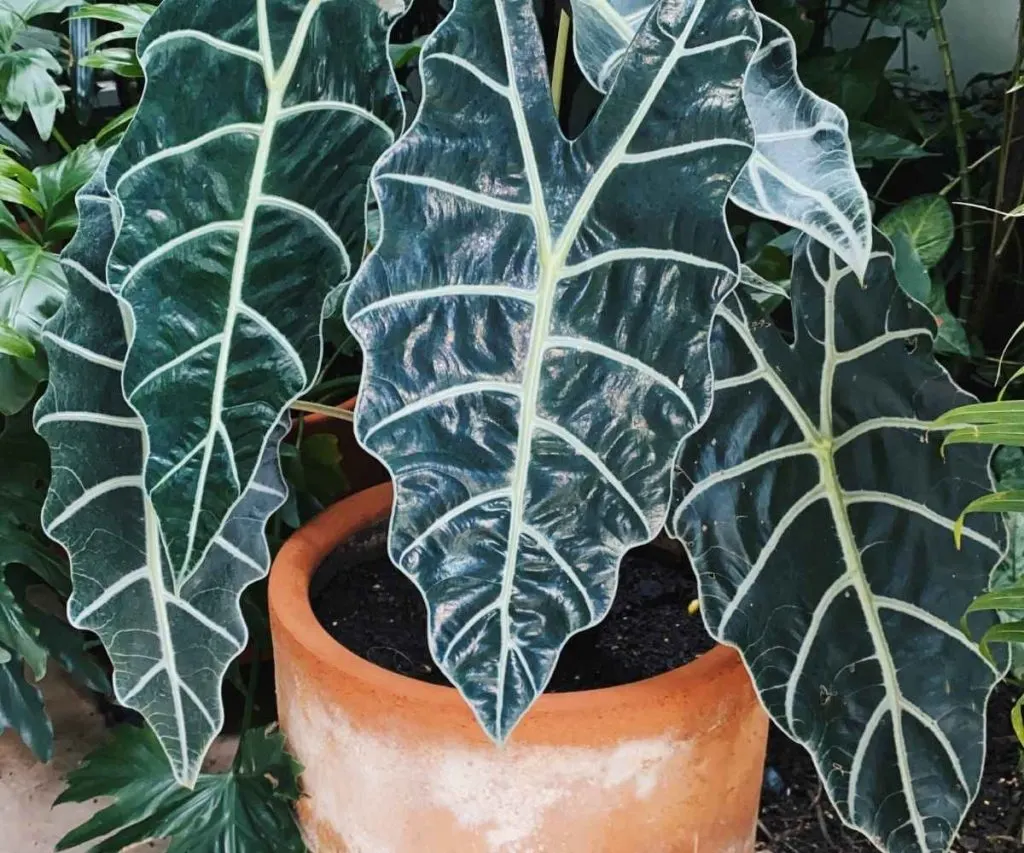
These plants are Aroids. We have many aroids on this blog. They often make very great houseplant companions for us. In fact they are often extremely easy to care for.
The Polly is also a good houseplant… IF you can give her what this fussy girl wants.
What? Fussy? Well they are not QUITE as touchy as Calatheas like the Orbifolia or White fusion.
Shop Alocasia Polly On Etsy
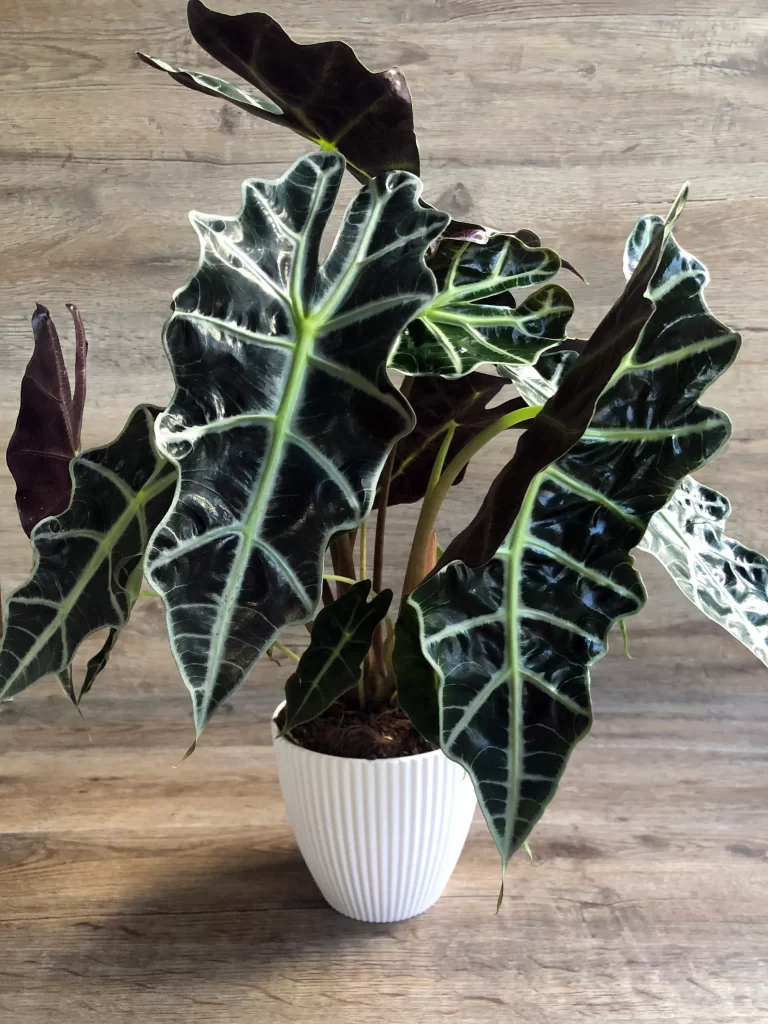
However, You need to take our care tips for the Polly seriously. Otherwise this plant will be looking very bad. And probably eventually die.
I have the Alocasia Bambino and it has taught me what happens when I don’t pay attention. Brown tips on leaves, yellowing leaves and …not a pretty situation.
I repotted my bambino into LECA. It does seem to enjoy growing this way.
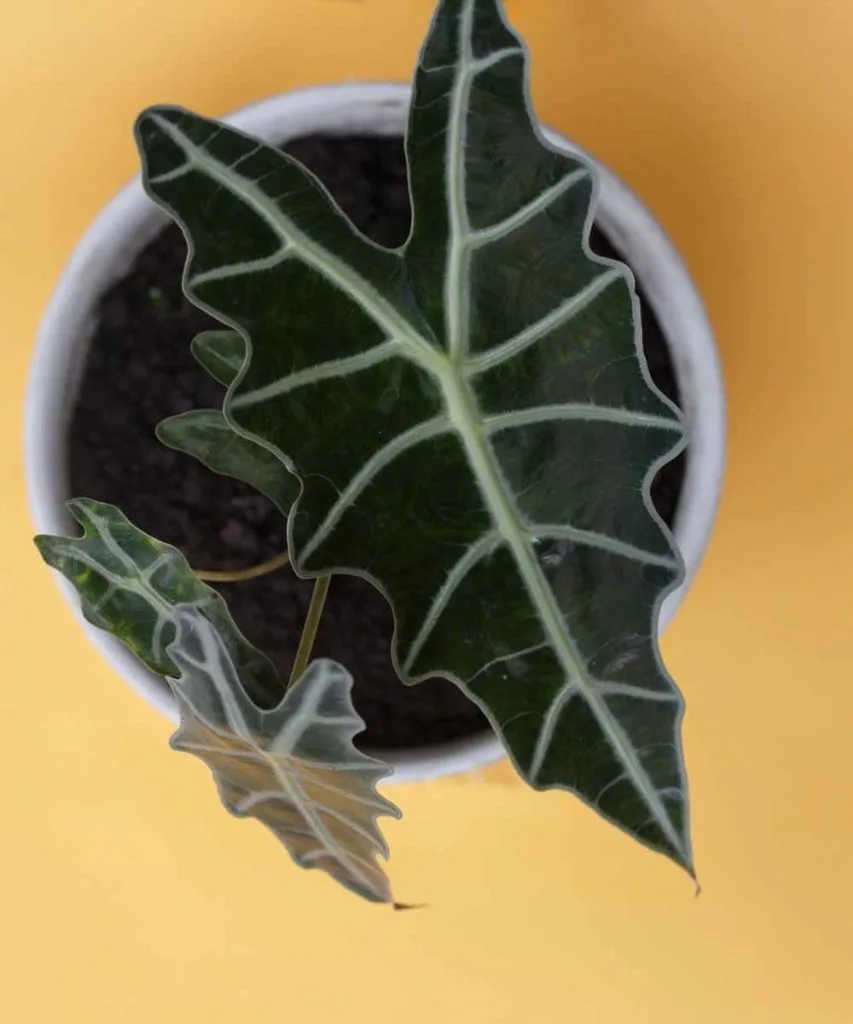
The Amazonia will also require you to pay attention to it. But it’s so cool. It’s worth it. Just don’t make this your very first plant unless you are ready to jump on plant care seriously.
Alocasia Polly Care is rather simple fortunately. Read our complete Care guide below to learn all the details on keeping this interesting plant happy throughout the year.
Alocasia Polly Plant Care Guide
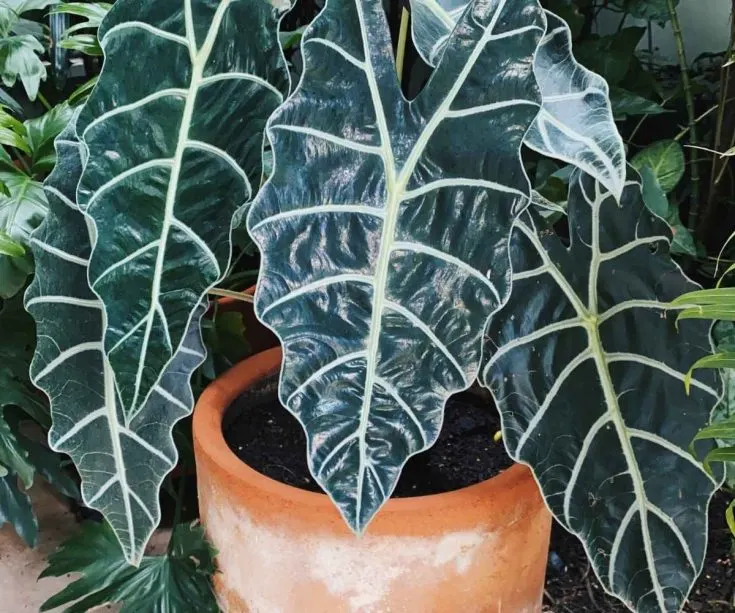
Alocasia Polly plants are gorgeous with long arrowhead shaped leaves, bright veining, and a purple underside of the leaf.
This Care Guide will teach you how to keep this plant happy all through the year.
Tools
Instructions
Soil Preference:
- This plant requires a light well draining soil mix. Polly needs moist soil, but cannot have water compact around the roots.
- A mix of potting soil, succulent soil mix and orchid soil mix (look for one with a lot of peat and finer bark mix) will keep the roots happiest.
- Two parts potting soil to two parts succulent mix to two parts orchid bark.
- A heavy soil potting mix is not recommended for this plant.
Pot Size and Type:
- This plant is fairly slow growing and needs a pot only an inch or two above the previous pot size.
- Any NON porous well drained pot can be used. It MUST have a drainage hole. Terra cotta wicks away too much water from the soil and is not the best pot material for Alocasias
- Repot every second year or when roots come out the drainage holes on the pot bottom.
Lighting:
- Alocasia Polly requires bright indirect light
- Shield this plant from strong direct light in summer south and west sunny windows. The leaves will burn.
- Tip: Window sheers or blinds can offset some brief periods of high direct light.
Watering:
- Try a watering schedule of every week. Water thoroughly until the water runs out of the pot.
- Watering is best done on a regular schedule so the plant is not over or under watered. Both can cause stress on the plant.
- Never let this plant get wet feet. Alocasias enjoy moist soil but cannot tolerate heavy compacted wet soil. If the soil is compacted the bottom of the soil can remain wet which encourages root rot and fungus gnats.
- In Fact, These plants are good candiates for growing in semihydroponics like LECA.
Humidity:
- Alocasias need humidity. Set the container on a pebble tray with water under the pot or provide a humidifier to this tropical plant for best growth and happiness.
- Make sure you are not keeping your plant next to a heat or air vent. This will dramatically lower the humidity level.
- humidity also improves when you group plants together more closely.
How to Fertilize:
- Alocasias require regular fertilizing.
- Apply a good quality fertilizer (linked in materials) monthly through Spring and summer.
- Alternately you can use a slow release fertilizer at the beginning of the growing season.
- Decrease feedings by late Fall and allow the plant to rest through the winter months.
Temperature:
- Keep this plant at a low of 60 Degrees F. to upward of 85 Degrees F. It enjoys warmth and humidity.
Pests:
- Alocasias can be attacked by pests
- Stress by longterm overwatering, poor light, extreme temperatures and soil conditions are contributors to plant stress..
- Spider mites, mealy bugs, scale, thrips and whitefly are the most common houseplant pests you will see.
- Read our post on How to get rid of aphids and other pests with our homemade pesticide soap recipe or neems oil.
- To minimize the possibility of pests be sure to check all nursery plants before bringing them home.
- Quarantine all new plants until you are sure no pests live in them.
How to Propagate:
- This plant is easily propagated through rhizome division.
- Start with a healthy and mature Alocasia plant
- Divide the rhizomes when repotting the plant
- Plant new rhizome start into a pot with similar soil mix to the mother plant.
- Keep the soil moist while the new plant acclimates and matures
Toxicity:
1. This plant is considered toxic. Do not ingest any part of the plant. This plant can also cause mild skin irritation. Keep away from children and pets.
Notes
The video bleow applies to the Alocasia Polly as well as the bambino.
Follow Us:
Find us on YouTube, Instagram , Pinterest and TikTok! We love to Plant chat. We also comment, like and occasionally share your content to our daily stories. We’d love to see your plants. Share your joy in your houseplants. Happy Planting!
Recent Posts:
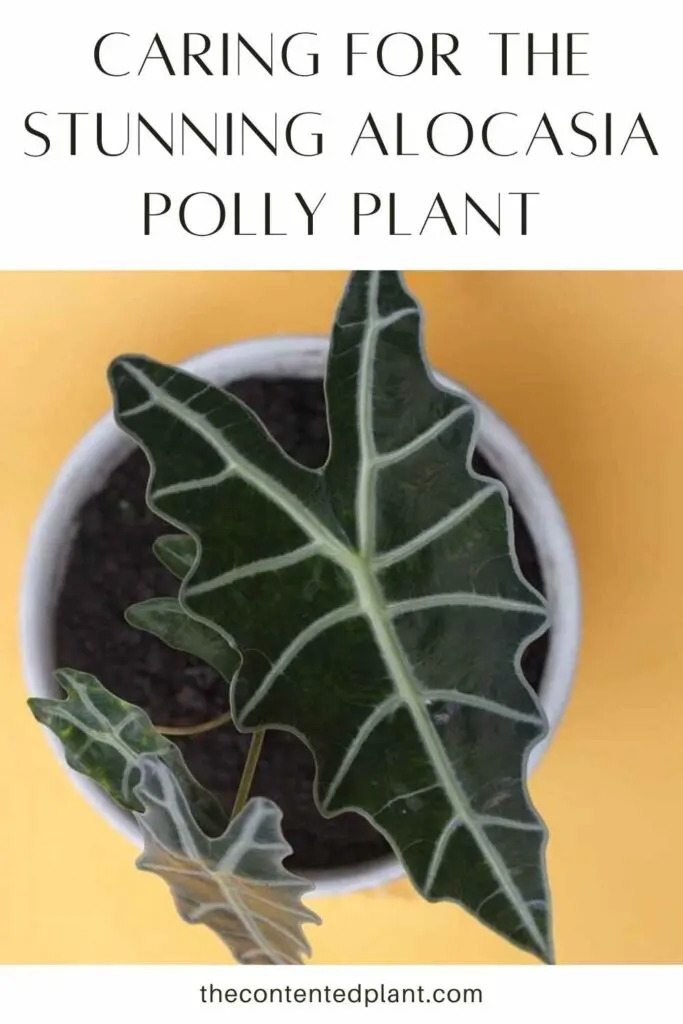

Tena Bunch
Sunday 13th of August 2023
I have a question my plant looks wonderful and all is well except every so often one leaf seems to go bad and rot away not sure why? It came home with me fresh off the cart from the nursery about 3 months ago its still in nursery pot. Any ideas? Been looking around on line I know I cant be the only one with this question. Ant help would be greatly appreciated.
Diane Williams
Monday 14th of August 2023
Hi Tena, Leaf rot can be caused by a variety of factors, and it's important to identify the underlying cause to address it effectively. Here are some possibilities:
Overwatering: Alocasia plants are susceptible to root rot if they are consistently overwatered. Make sure the nursery pot has good drainage, and allow the top inch or so of the soil to dry out before watering again. Watering when the soil is too wet can lead to fungal growth and root rot, which may manifest as leaf rot. Inadequate Drainage: If the nursery pot OR SOIL doesn't have proper drainage, excess water may accumulate around the root zone, leading to root rot and subsequently causing leaf issues. Consider repotting the plant into a well-draining pot with drainage holes. Water Quality: Poor water quality can contribute to leaf problems. If you're using tap water, it might contain chlorine or other chemicals that can harm the plant over time. You could try using filtered or distilled water to avoid these issues. Humidity Levels: Alocasia plants thrive in high humidity environments. If the air around the plant is too dry, it can lead to stress and potential leaf problems. You might consider using a humidity tray, misting the leaves, or using a humidifier to increase the moisture in the air. Temperature Extremes: Alocasia Polly prefers warmer temperatures and can be sensitive to sudden temperature fluctuations. Avoid placing the plant near drafts, heaters, or air conditioning vents. Fungal or Bacterial Infections: Sometimes, fungal or bacterial infections can affect the leaves, causing them to rot. Ensure that you are providing good air circulation around the plant and avoid splashing water onto the leaves. Pests: Although less common, pests like mealybugs or aphids can also lead to leaf damage and rot. Inspect the plant carefully for any signs of pest infestation. To address the issue, Trim away any affected leaves to prevent the spread of possible diseases. A repot might be in order if the pot or soil in not the correct type.
Alocasia Regal Shield - The Contented Plant
Tuesday 15th of February 2022
[…] Alocasia Polly […]